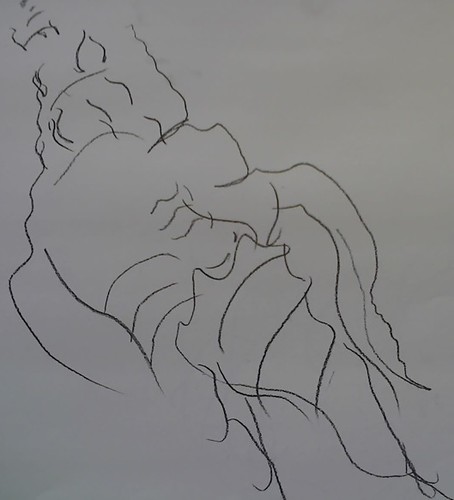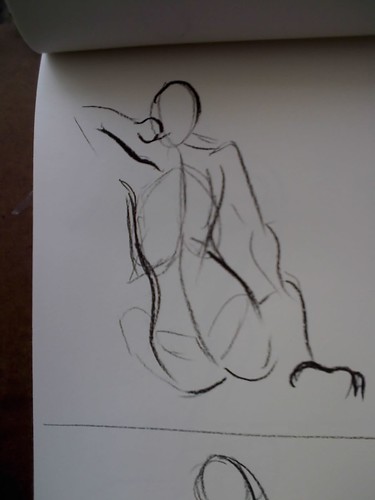We took a field trip to the Walker Art Center, a museum I'm very familiar with. They are currently showing a couple different featured exhibits.
The first was entitled "Naked" and was an interesting installment. It was a live exhibition by two japanese artists, Eiko and Koma. You are greeted by a huge sheet of scorched canvas encrusted with salt and covered in rooster feathers. I wanted to reach out and touch it, to feel the contrast between the roughness of the canvas, burned to brittle dust in places; the sharp edges of the salt crystals, the silky smoothness of the feathers.
Behind the canvas the two artists lie in a bed of straw and feathers, unobtrusive benches placed all around for viewing. They move sinuously, slowly, toward each other and away again. The lights are dim and centered on the couple. in the background water drips intermittently, breaking the perfect, reverent silence. This exhibit was interesting from a life drawing perspective because of the artists themselves. Their painfully slow movements threw their muscles into sharp relief. the flex of a calf or the tension in a hand was held for long enough to study.
The second was a large exhibit featuring the works of French artist Yves Klein. I have mixed feelings about this artist's vision and his technique. He worked almost exclusively in monochrome. I was unimpressed by his color studies, but once the depth of texture was introduced I was more appreciative of his work. I found the sponge and coral pieces particularly interesting.
I feel like the introduction of texture lent a massive amount of depth to his work. By using a complex, organic form he was able to show the complexity of that color.
His city of the future designs were interesting, but nothing really spoke to me like the sponges.
I also had the pleasure of walking through the Sculpture Garden and introducing a friend to the Spoon and cherry.
Next we travelled to the University of Minnesota and visited the Bell Museum of Natural History, which, despite my growing up in the cities (some of my childhood was spent ON CAMPUS, as both my parents were students there) I had never been to!
It. Was. Awesome. The animals in the diorama were wonderful to look at. So much texture. But my favorite part was the touch and see room. I think I spent more time talking to the staff about the various specimens than anything else. As someone who spends a good deal of time with younger kids, I like to think I've never lost the child-like wonder and curiosity that so many people stifle as they grow intellectually. So for me, the visceral pleasure of bones, pelts, and live reptiles was amazing.
The walker may be a little more conceptual and high-brow than I typically like to indulge in, having more preference for the work of the masters and the pre-raphaelites, but I will DEFINITELY be going back to the Bell, and I'll be bringing friends.








